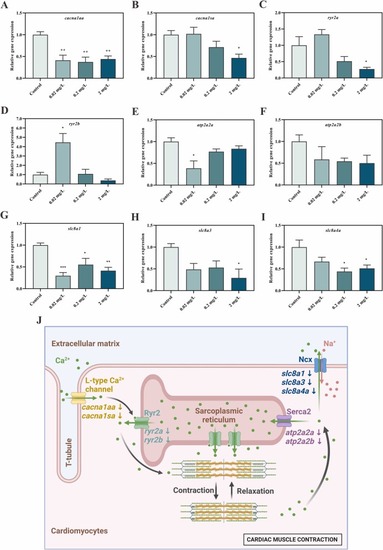Fig. 5
- ID
- ZDB-FIG-240205-15
- Publication
- Lin et al., 2023 - Exposure to echimidine impairs the heart development and function of zebrafish larvae
- Other Figures
- All Figure Page
- Back to All Figure Page
|
Echimidine exposure impairs the gene expression of calcium signaling pathway. (A-I) Gene expression of calcium signaling pathway in zebrafish larvae exposed to echimidine for 72 h. Values were normalized against gapdh. The data were analyzed by one-way analysis of variance (ANOVA) followed by Tukey’s multiple comparisons test and presented as the mean ± SEM (n = 3). * p < 0.05, ** p < 0.01, *** p < 0.001 and **** p < 0.0001. (J) The proposed mechanism of echimidine affecting the contraction of cardiomyocytes in zebrafish larvae. Echimidine exposure initially reduces the mRNA expression of cacna1aa and cacna1sa in L-type voltage-dependent calcium channels, resulting in a reduced influx of calcium ions from extracellular mediators into the cytoplasmic matrix. As a consequence, it delays the opening of the calcium channel Ryr2, which needs to bind to calcium ions on the sarcoplasmic reticulum (SR) membrane. Additionally, the mRNA expression of ryr2a and ryr2b also decreased after echimidine exposure. These combined effects seriously hinder the release of calcium from the SR in cardiomyocytes, leading to a relative decrease in cytoplasmic calcium concentration. This relative decrease in calcium concentration disrupts the binding rate of troponin and calcium, restricting the sliding of thick and thin myofilaments and ultimately impairing the contractile ability of cardiomyocytes. |

